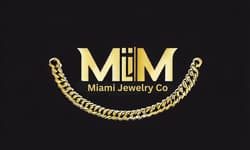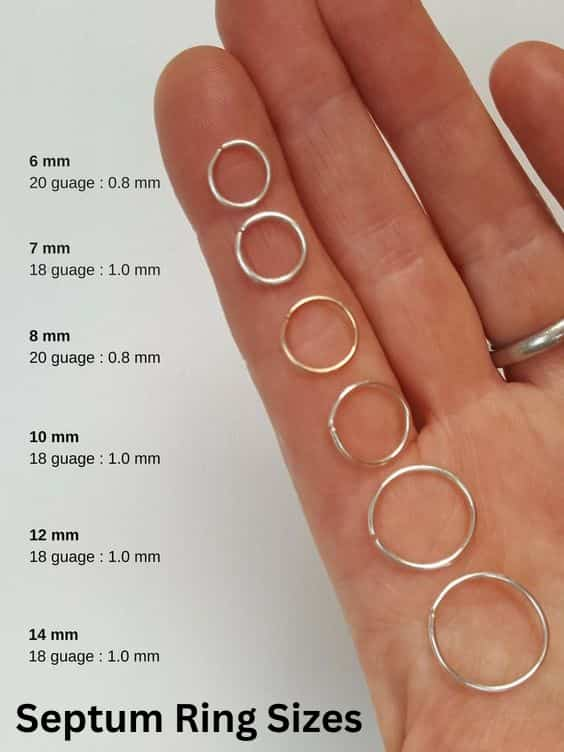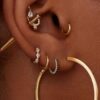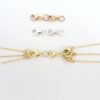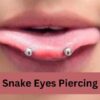Nose Piercing
Septum Ring Sizes: What Gauge is a Septum Piercing and Why It Matters
Ever chosen the wrong septum ring size and faced irritation or even infection?
It’s a problem many face, and the consequences can be serious. With my years of professional piercing experience, I’ve created a guide to help you avoid these common pitfalls.
We’ll explore:
- What gauge is a septum piercing?
- How to choose the right size for you.
- Common mistakes to avoid.
- Types of jewelry used.
I’ll provide you with straightforward advice, videos, and answers to frequently asked questions. With my hands-on knowledge, I’ll guide you to the perfect fit, so you’ll never have to worry about the wrong septum ring size again.
Let’s get started!
Importance of Choosing the Right Size
Selecting the proper size isn’t just about appearance; it also ensures comfort and minimizes the risk of complications. I know you want your septum ring to look fantastic and feel great, so let’s dive into how you can achieve that.
Contents
- 1 What Gauge is a Septum Piercing?
- 2 Septum Ring Sizes Explained
- 3 How to Choose the Right Size for You
- 4 What is the smallest septum ring size?
- 5 What Is My Septum Piercing Gauge?
- 6 Septum Ring Diameter
- 7 How do you measure septum ring size?
- 8 Septum Ring Sizes Video Guide
- 9 What size septum ring do you get pierced with?
- 10 Mistakes to Avoid When Choosing Septum Ring Sizes
- 11 What Types of Jewelry Are Used for Septum Piercings?
- 12 FAQs
- 13 Conclusion
What Gauge is a Septum Piercing?
In the context of septum piercings, the term “gauge” refers to the thickness of the piercing jewelry. Understanding the gauge is crucial for the comfort, healing, and appearance of a septum piercing.
Here’s a detailed look:
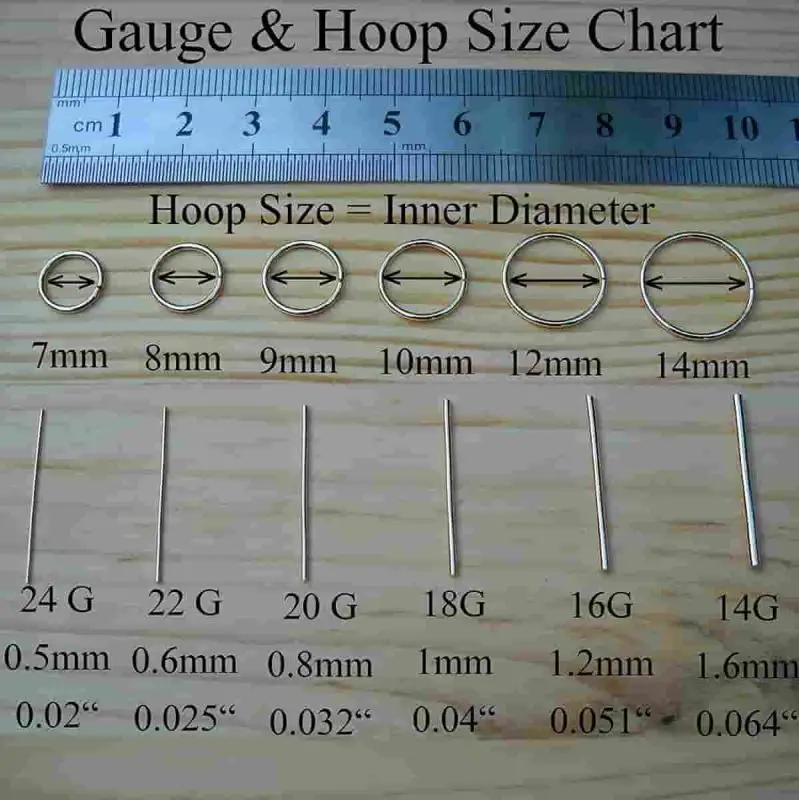
What is Gauge:
Gauge represents the thickness of the piercing jewelry, typically measured in a numeric scale where a smaller number means a thicker size. It’s an essential attribute to consider when selecting the right jewelry for your piercing.
What is the standard size septum ring?
The standard gauges for septum piercings are usually 16G (1.2 mm) or 14G (1.6 mm). These sizes provide a balance between durability, comfort, and aesthetics.
- Related: Nose Hoop Size for Your Piercing

Gauge Versus Thickness:
The relationship between gauge and thickness is inversely proportional. That means a lower gauge number corresponds to a thicker piece of jewelry, and vice versa. For example, 12G is thicker than 16G.
Impact on Healing and Comfort:
Choosing the right gauge is crucial for the healing process and ongoing comfort. A gauge that’s too thick or too thin might lead to complications or discomfort.
Professional Guidance:
Experienced piercers usually recommend the appropriate gauge based on individual anatomy and the type of jewelry selected. Returning to the shop where the piercing was performed to confirm the correct gauge size is often advisable.
Gauge Video Guide
Septum Ring Sizes Explained
Diameter and Gauge
When talking about septum ring sizes, two key terms are diameter and gauge. The gauge refers to the thickness of the ring, while the diameter pertains to the ring’s overall size.
Common Sizes
The common gauges for septum rings range from 16G to 14G, with diameters varying between 8mm to 14mm. Don’t worry if this sounds confusing; I’ll explain how to figure out the best size for you.
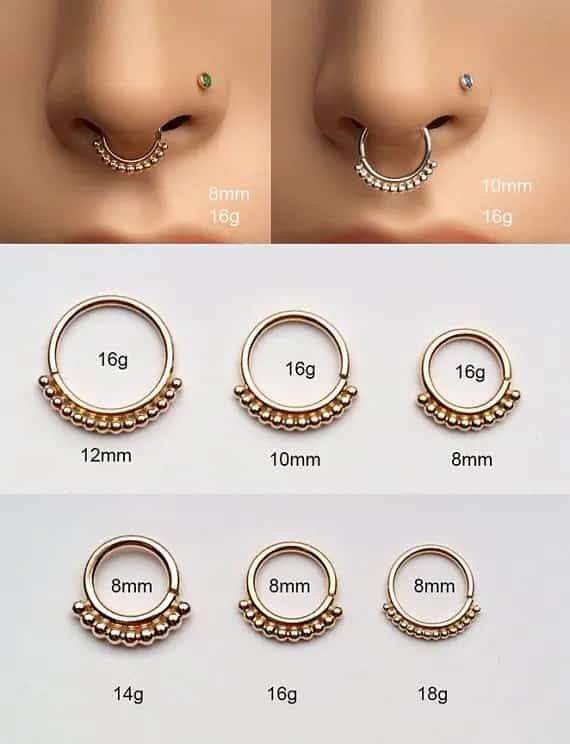
How to Choose the Right Size for You
Determine Your Septum Size
The anatomy of your nose plays a critical role in determining the right size. Just as you wouldn’t wear shoes that don’t fit, you shouldn’t select a septum ring that doesn’t align with your unique anatomy.
Consider Your Comfort Level
You know yourself best, and comfort should be your priority. If you prefer a snug fit, a smaller diameter might suit you. If you’re all about making a statement, perhaps a larger diameter is your go-to.
Professional Guidance
Sometimes, it’s best to seek professional guidance. A skilled piercer will not only measure your septum accurately but also provide expert recommendations tailored to you.
What is the smallest septum ring size?
When it comes to the smallest septum ring size, it is typically measured at 18 or 20 gauge (G), which is equivalent to a diameter of approximately 1.0mm to 0.8mm respectively. This minimal gauge size is favored by those seeking a subtle enhancement, as it delicately accents the nasal septum without being overly conspicuous
- Learn more about Small Septum Piercing
What Is My Septum Piercing Gauge?
The gauge size of a septum ring refers to the thickness of the jewelry inserted into the piercing, akin to selecting the appropriate size of a straw for a beverage. Generally, individuals opt for a 16G or 14G gauge size for their septum piercing, with 16G being slightly finer in diameter. The optimal gauge size is often influenced by the specific contours of one’s nose and personal aesthetic preferences. Hence, consulting with a professional piercer is always advised. Their expert guidance ensures the selection of the most suitable jewelry, harmonizing both visual appeal and comfort, tailored to the individual’s unique style and anatomy.
Septum Ring Diameter
The septum ring diameter refers to the internal measurement of the ring, describing how wide the ring is across its center. This measurement is significant for those who wear septum piercings, as the diameter directly impacts both comfort and appearance. Here are key aspects to consider:
Standard Sizes:
Typical septum ring diameters range from 8mm to 14mm, with the choice depending on the wearer’s preference, the size of the nostrils, and the desired look.
Importance of Proper Sizing:
Choosing the correct diameter ensures the ring sits appropriately in the nose, neither drooping too low nor fitting too tightly. An improper diameter can lead to discomfort, migration, or other complications.
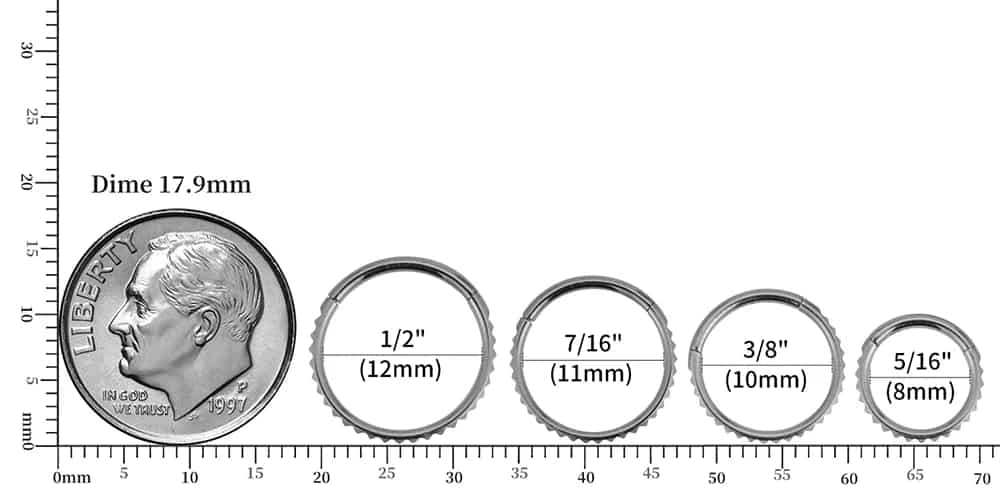
How do you measure septum ring size?
Measuring the size of a septum ring requires understanding both the gauge (thickness) and the diameter (length across the ring). Here’s how you can do it:
You can’t use just any tool to figure out your septum gauge. A regular ruler won’t do the trick!
How to Find Out Your Septum Ring Size Gauge Using Professional Tools:
Calipers:
These are specialized tools that can measure the exact thickness of your existing septum jewelry. They are typically used by professionals to ensure accurate measurement.
Gauge Card:
If available, this can provide a quick reference for gauge size, but accuracy depends on the card being scaled.
Professional Assistance:
Visiting a piercer to assist in finding the right size for your septum ring is often the most accurate method.
How to Find Out Your Septum Ring Size using DIY Methods:
Paper and Ruler:
You can use a thin strip of paper and a ruler to get a rough idea of the diameter. By positioning the paper over the piercing hole and marking the bottom with a pen, you can then measure it using a ruler.

Reference Jewelry:
If you have existing jewelry that fits well, you can measure its diameter as a reference for new purchases.
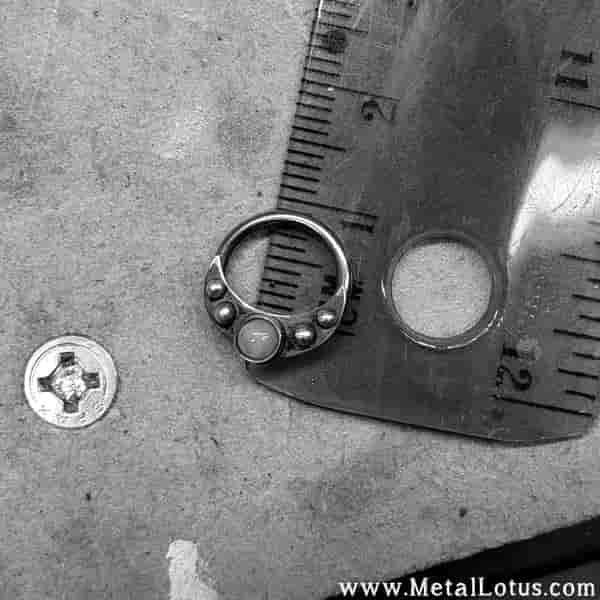
Considerations for Comfort:
It’s essential to choose the right size that feels comfortable for your nose. This might require experimenting with different diameters and gauges to find the ideal fit.
Septum Ring Sizes Video Guide
What size septum ring do you get pierced with?
When you get a septum piercing, the piercer often uses a 16 or 14 gauge needle. These sizes are like 1.2mm and 1.6mm rings. These sizes are common because they let the pierced area heal well. They are big enough to handle swelling that might happen after the piercing. Once the piercing heals, you can choose a different size or style if you want.
It’s always good to talk to the piercer, who knows what size and style will work best for you.
Mistakes to Avoid When Choosing Septum Ring Sizes
Choosing the perfect size for your septum ring is a delicate balance that requires attention and care; here are common mistakes to watch out for to ensure your choice enhances both your comfort and style.
Ignoring Measurements:
Neglecting to take accurate measurements of the septum can lead to discomfort and potential damage. Always ensure to measure or consult with a professional.
Choosing Style Over Comfort:
While the design and aesthetics of a septum ring are essential, don’t overlook comfort. Picking a ring that is too large or small may cause irritation or complications.
Not Considering Healing Process:
If it’s a new piercing, be mindful of the swelling that may occur during the healing process. Choosing a size without considering this factor might cause problems later on.
Disregarding Material Allergies:
Selecting a ring made from materials that cause allergies can lead to serious skin issues. Always check the material composition before buying.
Overlooking Daily Lifestyle:
Failing to consider daily activities and lifestyle may lead to choosing a size that is impractical for everyday wear.
Ignoring Professional Advice:
Attempting to select a size without consulting a professional piercer can lead to mistakes in judgment. Expert advice should always be considered.
Buying Cheap Quality Products:
Choosing cheap or low-quality rings, even if they are the correct size, can lead to breakage, discomfort, or infections.
Forgetting Future Jewelry Changes:
If you plan on switching jewelry styles, failing to consider how the size might affect future choices could limit your options later on.
Misjudging Gauge Sizes:
Selecting the wrong gauge size (thickness) can cause undue stress on the piercing. Understanding the correct gauge size is essential for proper fitting.
Rushing the Decision:
Hasty decisions can lead to picking the wrong size. Taking the time to consider all aspects ensures a better fit and overall satisfaction.
Not Considering Weight:
Heavier jewelry may not be suitable for everyone. Ignoring the weight of the ring can lead to discomfort and long-term issues.
Lack of Aftercare Consideration:
Failing to think about the aftercare process and how the size of the ring may affect it could lead to complications during healing.
Ignoring Personal Preferences:
What may be suitable for someone else might not be for you. Ignoring personal preferences and comfort can lead to dissatisfaction with the chosen ring.
Forgetting Occasional Swelling:
Changes in weather, diet, or other factors can cause occasional swelling. Ignoring this aspect while choosing the ring size might lead to occasional discomfort.
Avoiding Return Policies:
Always check the return and exchange policies when purchasing. Choosing the wrong size without an option for exchange can lead to unnecessary expenses and disappointment.
What Types of Jewelry Are Used for Septum Piercings?
When it comes to selecting jewelry for a septum piercing, the options can be as diverse as the individuals who wear them. Understanding the different types and what they bring to one’s aesthetic can be an enriching experience.
Here’s an insightful guide to the types of jewelry used for septum piercings.
Horseshoe Rings
Horseshoe rings, also known as circular barbells, have a striking appearance, resembling a U-shape or a horseshoe. Typically made from surgical steel, titanium, or other hypoallergenic materials, these rings provide flexibility and a unique appeal. They’re available in various sizes, making them suitable for different preferences, and the exposed ends can be adorned with balls or spikes for an added edge.
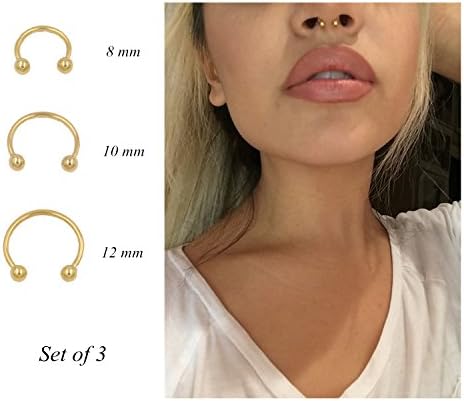
Captive Bead Rings
Captive bead rings (CBRs) are classic and versatile. A small bead, often made from metal, glass, or gemstone, is held captive by the ring’s tension. This bead can be a simple or decorative element that adds a touch of elegance. They’re well-suited for those who prefer a seamless and understated look.
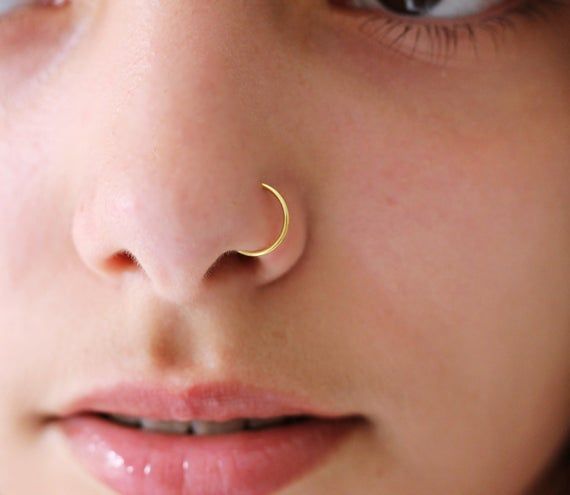
Clickers
If you’re looking for something that offers ease of use, clickers may be your go-to choice. These septum pieces have a hinged mechanism that “clicks” into place, allowing for effortless insertion and removal. With various designs and embellishments, clickers offer a fantastic blend of style and convenience.
Septum Retainers
Not all septum jewelry is meant to be flashy. Septum retainers are discreet pieces designed to keep the piercing open when more overt jewelry might be inappropriate, such as at work or during specific activities. They’re generally made from clear or flesh-toned materials, allowing them to blend with your natural appearance.
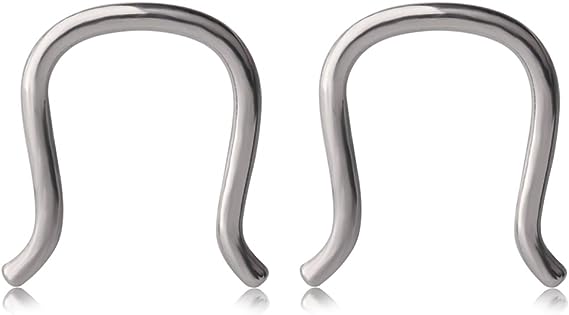
Seam Rings
Seam rings present a continuous and sleek look, making them a favorite among those seeking sophistication. The smooth, unbroken design lends a minimalist charm and is available in materials like gold, silver, or platinum. These rings might require professional assistance for insertion and removal due to their snug fit.
FAQs
What is the standard gauge for septum rings?
The standard gauges are usually 16G and 14 G.
How do I know the right diameter for my septum ring?
Measuring an existing ring or seeking professional guidance can determine the right diameter.
Can I change my septum ring myself?
With the correct size information and careful handling, you can, but professional assistance ensures the best results.
Is it normal for a new septum ring to feel tight?
A slight tightness can be normal, but extreme discomfort may indicate the wrong size.
How often should I clean my septum ring?
Regular cleaning according to the guidelines provided by your piercer or the ring manufacturer is essential.
Conclusion
Choosing the right septum ring size is a blend of understanding the terminology, knowing your body, considering comfort, and seeking professional guidance when needed. By following the insights shared in this article, I’m confident you’ll find the perfect fit that reflects your style and ensures comfort.
Our Popular Collection:
Black Septum Rings, Surgical Steel Septum Rings, Horseshoe Septum Rings, 8mm Septum Ring, 10mm Septum Rings, 12mm Septum Ring, 10g Septum Ring, 12g Septum Ring, 14g Septum Ring, 16g Septum Ring, 18g Septum Ring, 18g Septum Ring Dainty Septum Ring Men Septum Rings.

Camila Luna is a passionate jewelry enthusiast and content creator at Miami Jewelry Co. With a focus on providing high-quality, Miami-style jewelry, Camila and her team specialize in a wide range of jewelry that includes bracelets, necklaces, earrings, and more
